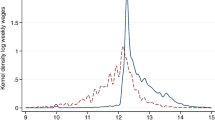Abstract
We propose measuring individual employability as a weighted average across occupations of a worker’s predicted wage for each occupation. Weights are given by the individual occupational probability distribution. Under this measure, a worker is more employable than another if she has a greater chance to obtain a better paid occupation. After normalization, expected employability corresponds to the population correlation between occupational predicted wages and the chance to obtain employment in these occupations and serves as a measure of the allocative efficiency of labor market. We apply the methodology to Brazil and found that employability increased and became less unequally distributed from 2002 to 2011. We used a decomposition method to investigate the causes of these changes. Although average normalized employability is weakly positive, it has increased for the period, which suggests that there is room for efficiency gains in the allocation of workers to occupations in the Brazilian labor market.
Similar content being viewed by others
References
Arocena, P., Nuñez, I., Villanueva, M.: The effect of enhancing workers’ employability on small and medium enterprises: evidence from Spain. Small Bus. Econ. 29, 191–201 (2006)
Autor, D., Katz, L., Kearney, M.: Trends in U.S. wage inequality: revising the revisionists. Rev. Econ. Stat. 90, 300–323 (2008)
Card, D., Ibarrarán, P., Regalia, F., Rosas-Shady, D., Soares, Y.: The labor market impacts of youth traning in the Dominican Republic. J. Labor Econ. 29, 267–300 (2011)
Chow, G.: Technological change and the demand for computers. Am. Econ. Rev. 57, 1117–1130 (1967)
De Grip, A., Van Loo, J., Sanders, J.: The industry employability index: taking account of supply and demand characteristics. Int. Labour Rev. 143, 211–233 (2004)
Finnie, R., Meng, R.: Literacy and employment. Perspect. Labour Income 8, 5–13 (2007)
Firpo, S., Fortin, N., Lemieux, T.: Unconditional quantile regressions. Econometrica 77, 953–973 (2009)
Fortin, N., Lemieux, T., Firpo, S.: Decomposition methods in economics. In: Ashenfelter, O., Card, D. (eds.) Handbook of Labor Economics, pp. 1–102. Elsevier, 4A (2011)
Gazier, B.: Observations and recommendations. In: Gazier, B. (ed.) Employability: Concepts and Policies, pp. 298–315. European Employment Observatory, Berlin (1998)
Gazier, B.: Employability: the complexity of a policy notion. In: Weinert, P., Baukens, M., Bollerot, P., et al (eds.) Employability: From Theory to Practice, pp. 3–23. Transaction Books, New Brunswick, NJ (2001)
Goos, M., Manning, A.: Lousy and lovely jobs: the rising polarization of work in britain. The Rev. Econ. Stat., MIT Press 89, 118–133 (2007)
Griliches, Z.: Hedonic price Indexes for automobiles: an econometric analysis of quality change. In: The Price Statistics of Federal Government. The National Bureau of Economic Research, New York (1961)
Groot, W., Maasen, H.: Education, training and employability. Appl. Econ. 32, 573–581 (2000)
Grusky, D., Ku, M.: Gloom, doom, and inequality. In: Grusky, D.B., Ku, M.C., Szelényi, S. (eds.) Social Stratification: Class, Race, and Gender in Sociological Perspective, pp. 2–28. Westview, Boulder, Colorado (2008)
Lancaster, K.: Consumer demand: a new approach. Columbia University Press, New York (1971)
McQuaid, R.: Job search success and employability in local labor markets. Ann. Reg. Sci. 40, 407–421 (2006)
McQuaid, R., Lindsay, C.: The concept of employability. Urban Stud. 42, 197–219 (2005)
Ronconi, L., Sanguinetti, J., Fachelli, S.: Poverty and employability effects of workfare programs in Argentina. PMMA Working Paper No. 2006–14 (2006)
Rosen, S.: The theory of equalizing differences. In: Ashenfelter, O., Layard, R. (eds.) Handbook of Labor Economics. 1st edn. chapter 12, vol. 1, pp. 641–692. Elsevier (1987)
Rosen, S.: The theory of equalizing differences. In: Ashenfelter, O., Layard, R. (eds.) Handbook of Labor Economics. 1st edn. chapter 12, vol. 1, pp 641–692. Elsevier (1987)
Sattinger, M.: Assignment models of the distribution of earnings. J. Econ. Lit. 31(2), 831–880 (1993)
Schmidt, P., Strauss, R.: The prediction of occupation using multiple logit models. Int. Econ. Rev. 16, 471–486 (1975)
Smith, J., McKnight, A., Naylor, R.: Graduate employability: policy and performance in higher education in the UK. Econ. J. 110, 382–411 (2000)
Thomsen, S.: Explaining the employability gap of short-term and long-term unemployed persons. Kyklos 62, 448–478 (2009)
Author information
Authors and Affiliations
Corresponding author
Electronic supplementary material
Below is the link to the electronic supplementary material.
Rights and permissions
About this article
Cite this article
Firpo, S., Carvalho, S. & Pieri, R. Using occupational structure to measure employability with an application to the Brazilian labor market. J Econ Inequal 14, 1–19 (2016). https://doi.org/10.1007/s10888-015-9313-3
Received:
Accepted:
Published:
Issue Date:
DOI: https://doi.org/10.1007/s10888-015-9313-3




